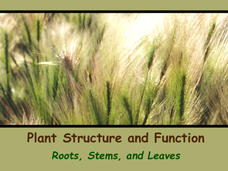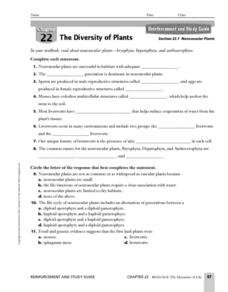Biology Junction
Nonvascular and Simple Vascular Plants: Mosses to Ferns
Sometimes conservationists use specific plants to prevent erosion or fight invasive species. A 50-slide presentation covers both nonvascular and vascular plants. It discusses the plants, their stages and life cycles, reproduction, uses,...
Curated OER
Characteristics of Plants
For this characteristics of plants worksheet, students name two things that all plants have in common. Then they describe how the cell walls and cuticles help plants adapt to life on land. Students also explain the difference between...
Biology Junction
Plant Structure and Function: Roots, Stems, and Leaves
Scientists found fossils of plants more than 420 million years old—but plants existed for up to 100 million years prior to these fossils. Learn about the importance of plants to the entire planet. Viewing a presentation helps scholars...
Biology Junction
Seed Plants: Gymnosperms and Angiosperms
One of the reasons plants found success on land relates to seed development. Scholars learn about many different forms of seeds and how they changed over time. It describes the structure and function of many different types of seeds in...
Curated OER
Seedless Plants
In this plant worksheet, students complete 1 short answer question and 6 fill in the blank statements using a word bank about seedless plants.
Curated OER
How Do Plants Move Materials?
In this plant worksheet, students will write 1 main idea on how plants move materials. Then students will write in 3 details about how nonvascular and vascular plants moves materials including the upward flow of water. This worksheet is...
Alabama Learning Exchange
What Kind of Plant is it?
Students evaluate the differences between vascular and nonvascular plants and practice classifying the plants into categories. They demonstrate using drawing software to create two slides showing vascular plants and nonvascular plants.
Curated OER
How Are Plants Classified?
In this plant classification worksheet, students compare and contrast the two groups of plants: vascular and nonvascular plants. This worksheet is a graphic organizer.
Curated OER
Non-Seed Vascular Plants
In this non-seed vascular plant instructional activity, students review the characteristics of sporophytes, lycophytes, sphenophytes, and pterophytes. This instructional activity has 19 fill in the blank, 4 true or false, and 2 short...
Curated OER
Reviving Celery
The classic in-class demonstration using celery dipped into water with food coloring is the highlight of this biology lesson plan. Young scientists discover that organisms are made up cells and have distinguishing characteristics. After...
Biology Junction
Plant Diversity
Ginkgo trees existed for more than 350 million years, and, at this time, only one species still remains. While plant diversity generally increases over geologic time, some interesting exceptions occur. Young scientists learn about plant...
Curated OER
Survey of the Plant Kingdom
In this plant kingdom worksheet, students will review the characteristics of the 12 divisions of the plant kingdom, comparing and contrasting their structures and life cycles. This worksheet has 17 matching, 5 short answer, and 5 fill in...
Curated OER
Evolution of Plants
This is a wonderful PowerPoint! It gives excellent details of different types of ferns and their characteristics which help them to survive and produce spores in many varied habitats.
Curated OER
Nonvascular Plants
In this nonvascular plant worksheet, students compare the characteristics of bryophyta, hepatophyta, and anthocerophyta. This worksheet has 8 fill in the blank and 3 multiple choice questions.
Curated OER
Monocots vs. Dicots
Students examine the differences in nonvascular and vascular plants. They compare the differences between gymnosperm and angiosperms. Students compare the differences between moocots and dicots. They view a powerpoint presentation on...
Curated OER
Kingdom Plantae
There are some great diagrams and labels on these slides that support the topic of plants. The definition of kingdoms, and summaries of the vascular systems and gamete production are given. This would be a perfect choice to kick off a...
Curated OER
Plant Diversity
In this nonfiction comprehension worksheet, learners read the selection on plant diversity and answer 10 questions that include true/false, short answer, multiple choice, and fill in the blank.
Curated OER
Plant Word Search Puzzle
In this science worksheet, students look for the words that are related to the concept that is reviewed in the sheet. They also acquire new vocabulary.
Curated OER
Practice with Ions
In this ions worksheet, students answer questions about atoms that have gained or lost electrons, they find the number of electrons atoms tend to gain or lose and they answer questions about bonding in atoms. They answer 6 questions...
Estrella Mountain Community College
Maricopa Community College: Nonvascular Plants and Nonseed Vascular Plants
Very detailed outline describing several aspects of plant diversity, including vascular vs. nonvascular, evolutionary adaptations, homosporous and heterosporous life cycles, and specific information on some ancient species (Lycophytes,...
Scholastic
Scholastic: Study Jams! Science: Plants: Plants Without Seeds
A slideshow and a short multiple-choice quiz on the topic of plants that reproduce without seeds.
Georgia Department of Education
Ga Virtual Learning: Ap Biology: Plants
Through informational text, practice problems, interactive animations, and video clips, studentl learn more about the amazing life of plants and how they function pretty well in their generally sedentary life.
Other
Nasa: The Case of the Prize Winning Plants [Pdf]
This program uses a scenario with fictional detective characters to present plant growth to students. While the unit focuses on the basic needs and parts of plants, the topics of plant classification and adaptations, soil formation and...






















